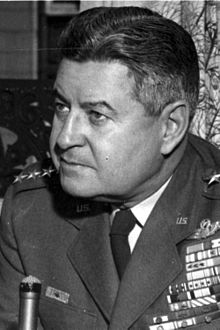Curtis LeMay: Difference between revisions
m categories |
|||
| Line 49: | Line 49: | ||
[[Category:1990 deaths|LeMay, Curtis]] |
[[Category:1990 deaths|LeMay, Curtis]] |
||
[[Category:Aerial warfare pioneers|Le May, Curtis]] |
[[Category:Aerial warfare pioneers|Le May, Curtis]] |
||
[[Category:Joint Chiefs of Staff|Le May, Curtis]] |
|||
Revision as of 01:11, 25 April 2005

Curtis Emerson LeMay (November 15, 1906–October 3, 1990) was a General in the United States Air Force. He is credited with creating an effective systematic strategic bombing campaign in the Pacific Theatre of World War II and later reorganizing the Strategic Air Command as a military arm for conducting nuclear war. However, he was also characterized by his opponents as a belligerent warmonger whose aggressiveness threatened to enflame tense international political situations like the Cuban Missile Crisis into war between the United States and the Soviet Union.
Biography
Born in Columbus, Ohio, he was educated in Columbus and at Ohio State University in civil engineering before joining the new Air Corps in 1928 through the ROTC. He was commissioned as a second lieutenant in 1930. He transferred to bomber aircraft in 1937 and soon demonstrated excellent abilities. His severe and demanding character earned him the nickname "Iron Ass". At the outbreak of World War II he was a group commander in the 8th Air Force. By early 1942 he was a lieutenant colonel and directed the 305th Group into action over Europe. He was given command of the 3rd Bombardment Division in late 1942 and in July 1944 he transferred to Pacific operations. He was promoted to major general and directed the 21st Bomber Command, heading B-29 operations including the massive incendiary attacks on over sixty Japanese cities, such as Tokyo on March 9-10, 1945 during which around 100,000 people were killed. The Japanese nicknamed him "brutal LeMay" (鬼畜ルメイ). In addition, he also oversaw Operation Starvation, an effective aerial naval mining operation of Japanese waterways and ports which severely disrupted the enemy's shipping and logistical operations.
Post-war he was briefly transferred to The Pentagon as Deputy Chief of Air Staff for Research & Development. In 1947 he returned to Europe as commander of USAF Europe, heading operations for the Berlin Airlift in 1948. He was back in the US by 1949 to replace George Kenney in command of the Strategic Air Command. He headed SAC until 1957, overseeing its transformation into a modern, efficient, all-jet-engined force. He was appointed Vice Chief of Staff of the United States Air Force in July 1957, serving until 1961 when he was made Chief of Staff of the United States Air Force on the retirement of Thomas White.
He was not a success as Chief of Staff; he was a belligerent and totally committed anti-Communist and clashed repeatedly with more flexible minds, such as Robert McNamara, Eugene Zuckert, and General Maxwell Taylor. LeMay lost a number of significant appropriation battles (for Skybolt ALBM, the F-111, and the B-52 replacement, the XB-70.) He also lost in his desire for a much more vigorous engagement in the Vietnam War. The quote "we should bomb Vietnam back into the stone age" is often attributed to him. His passion for promoting strategic air campaigns over tactical strike and ground support operations did come to be reflected in the Air Force, which became disproportionally strong in favour of strategic bombing operations during his tenure. Area bombardment of Vietnam, Laos and Cambodia led to the deaths and maimings of up to hundreds of thousands of innocent civilians during the wars in those countries.
LeMay retired in February 1965 and seemed to be headed for a potential political career. His highest accomplishment in politics was to be selected as the vice presidential candidate to segregationist George Wallace in 1968.
Fictional and nonfictional film portrayals
The character of General Buck Turgidson, played by actor George C. Scott in the 1964 film Dr. Strangelove, is said to be based on LeMay. The character is a warmongering hawk who, rather than help avert an imminent nuclear war, cheerfully proposes using the crisis to commit to a full preemptive strike that would cause the deaths of millions. The character of General Scott in the 1963 movie Seven Days In May is also said to be based on LeMay. Kevin Conway portrayed General LeMay in the 2003 film Thirteen Days.
Works
- (with MacKinlay Kantor) Mission with LeMay: My Story (Doubleday, 1965) ISBN B00005WGR2
- (with Dale O. Smith) America is in Danger (Funk & Wagnalls, 1968) ISBN B00005VCVX
- (with Bill Yenne) Superfortress: The Story of the B-29 and American Air Power (1988)
References
- Thomas M. Coffey, 1986. Iron Eagle: The Turbulent Life of General Curtis LeMay. Random House. ISBN 0517551888.
- Robert S. McNamara, 1995. In Retrospect: The Tragedy and Lessons of Vietnam. Vintage Press. ISBN 0679767495. (See pages 114-115).
- Albert Atkins, 2001. Air Marshall Sir Arthur Harris and General Curtis E. Lemay: A Comparative Analytical Biography. AuthorHouse. ISBN 0759659400.
- Alfonso A. Narvez. "Gen. Curtis LeMay, an Architect of Strategic Air Power, Dies at 83". The New York Times. October 2, 1990.
